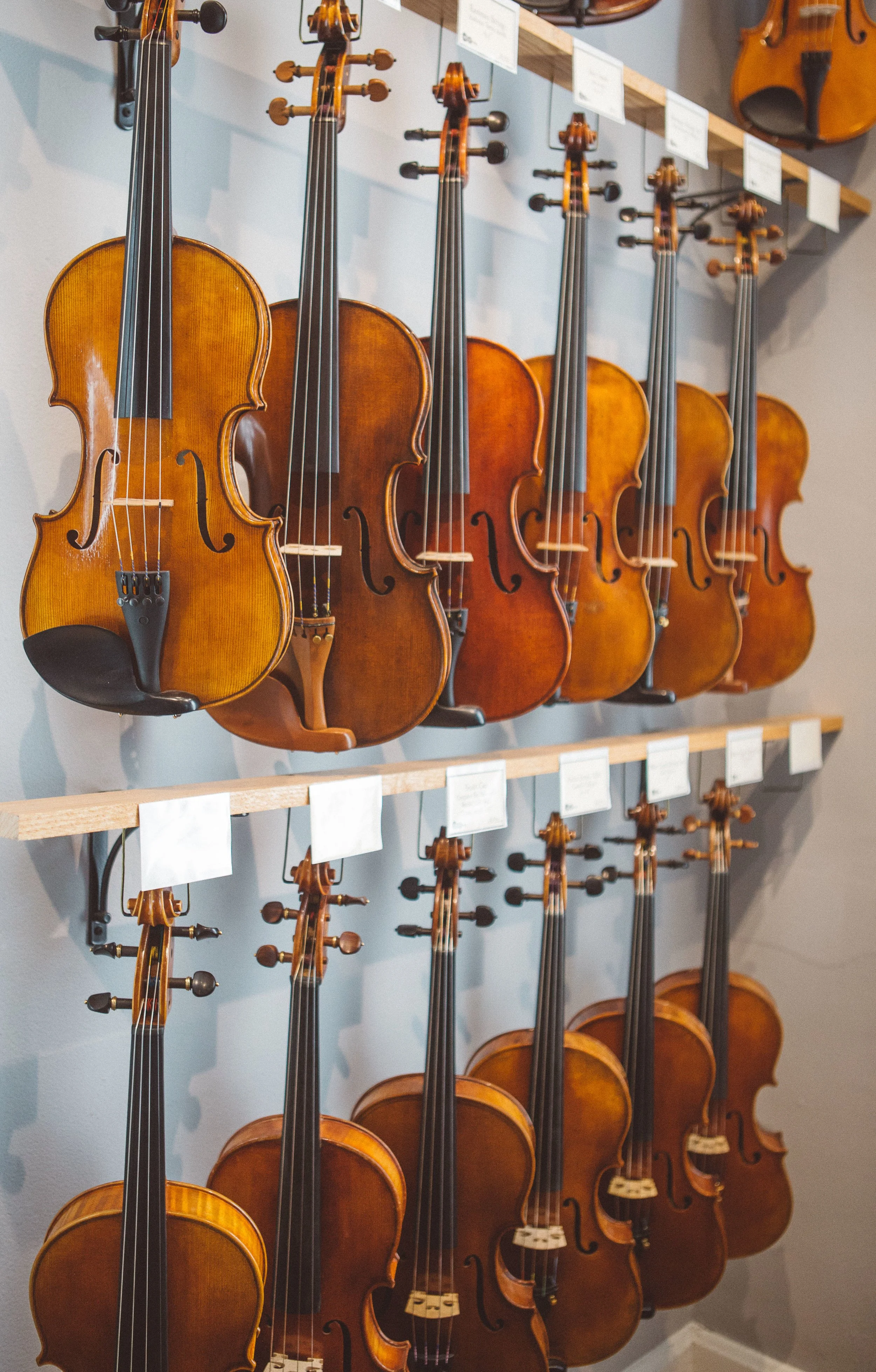HOW TO CHANGE STRINGS AND TUNE A VIOLIN
When it comes to playing the violin, changing and tuning the strings is a necessary skill to acquire. Whether you’re a beginner or an experienced player, knowing how to properly maintain your instrument can make a big difference to the quality of sound produced. In this article, I will provide you with step-by-step instructions on how to change and tune your violin strings, as well as answers to some of the most common questions about this process. Additionally, I’ll provide some tips to help you achieve the perfect sound and maintain your violin’s tune over time. Stringing and tuning a violin can seem like a daunting task for beginners, but with a little practice it can become second nature. Here are the steps to follow:
Steps to change your violin strings and tune your instrument
➤ Remove only one old string: start by loosening the strings. To loosen the strings, use the string adjusters or pegs to lower the pitch until the strings are loose enough to remove from the tailpiece and pegbox. Remove and replace the strings one at a time, rather than removing them all at once. This will help keep the bridge in place and prevent damage to the instrument.
➤ Clean the instrument: before installing new strings, it’s a good idea to give your violin a quick clean. Use a soft cloth to remove any dust or rosin from the body and fingerboard.
➤ Choose your new strings: there are many different types of violin strings available, and your choice of strings can make a big difference in the sound of your instrument. Consult a teacher or professional for recommendations, and be sure to choose the right size strings for your instrument.
➤ Install the new strings: start with the thinnest string (E string) and work your way up to the thickest (G string). Insert the ball end of the string into the tailpiece, then thread the other end of the string through the hole in the peg. Pull the string taut and turn the peg clockwise to tighten the string. Make sure the string wraps neatly and smoothly around the peg. Use the fine tuner to make minor adjustments.



➤ Tune the strings: use a digital tuner to tune your violin. Tighten each string from thickest to thinnest until it reaches the correct pitch, which is G-D-A-E. You can use the fine tuners to make small adjustments, but to make bigger changes, turn the pegs slowly as you push them into the pegbox to prevent them from slipping. If a peg is too loose or too tight in its hole, it may slip or become difficult to turn, so you can use a peg hole reamer or peg shaver to adjust the fit.
➤ Tension the strings: after you have tuned your violin, stretch the strings by gently pulling them away from the fingerboard with your fingers. This will help keep the strings in tune and improve the sound quality.
Avoid string breakage
Breaking strings when changing them on a violin can be frustrating and time-consuming. Here are some tips to help you avoid string breakage:
➤ Don’t overtighten the strings: overtightening can put too much tension on the strings and cause them to break.
➤ Use a fine tuner: if your violin has a fine tuner, use it to make small adjustments to the string tension. This will help you avoid overtightening the strings when tuning.
➤ Check the bridge: Before tightening the strings, make sure the bridge is straight and properly aligned. If the bridge is out of alignment, it can put too much pressure on the strings and cause them to break.
➤ Be gentle: when changing strings, handle the instrument gently. Avoid pulling or pushing the strings too hard, as this can cause them to break.
➤ Change one string at a time: to avoid putting too much tension on the instrument at once, it’s best to change one string at a time. This will prevent you from accidentally breaking several strings at once.
Violin tuning and weather changes
The tuning of a violin can be affected by changes in temperature, humidity and other environmental factors.
➤ Store your violin in a stable environment: the ideal temperature for storing a violin is between 15-21°C (60-70°F) and the relative humidity should be between 40-60%. Avoid storing your violin in areas that are too hot or too cold, or in areas that are too humid or too dry.
➤ Use a humidifier or dehumidifier: if you live in an area with high humidity, you may need to use a dehumidifier to keep the air around your violin dry. Conversely, if you live in an area with low humidity, you may need to use a humidifier to keep the air around your violin with enough moisture.
➤ Store your violin properly: when not in use, store your violin in a quality case that provides adequate protection from changes in temperature and humidity. Be sure to keep the case out of direct sunlight, which can also cause damage to the instrument.
➤ Tune your violin regularly: to ensure that your violin remains in tune, tune it regularly, ideally before each use. This will help you detect any changes in tuning caused by changes in weather or other environmental factors.
How to make sure the strings are tight enough and in tune
Before starting to play your violin, you need to make sure that the strings are tight enough. To do this, turn the pegs located at the top of the instrument to adjust the tension. Use a fine tuner to refine the sound further once the strings are close to pitch.
Getting the right tune can be tricky, but you will become more familiar with your instrument’s sound with practice. To get the right tune, use a tuner or tune your violin against another instrument or a piano. Start with the G string and then move on to the D, A and E strings.
If you have fine tuners installed on your violin, use them to make small adjustments. Turn the tuner to tighten or loosen the string until you get the desired pitch. If you can’t get the string in tune with the fine tuner, use the peg to make larger adjustments.
Helping your violin make the most beautiful music
➤ Proper technique and posture while playing can help you produce the most beautiful music possible. Make sure to hold the bow in the right way and keep your fingers positioned correctly on the strings.
➤ When removing old strings, be careful not to damage your violin. Loosen the string by turning the peg or fine tuner. Once the string is loose, unwind it from the peg or fine tuner and remove it from the tailpiece. Repeat for all four strings.
➤ Choosing the right type of string can greatly impact the sound of your violin. Experiment with different types of strings to find the one that works best for your instrument and your playing style.
➤ Once your violin is in tune, it’s important to keep it that way. Check the tune frequently while playing and make small adjustments as needed. Temperature and humidity changes can affect the tune, so be aware of changes in your environment.
How to properly use a tuner
➤ Place the tuner on a flat surface near your instrument and turn it on.
➤ Play each string and adjust the peg or fine tuner until the needle or display on the tuner is at the center or shows the correct pitch.
➤ Once all four strings are in tune, double-check the tune by playing a simple melody or using a tuning app.
➤ Even small adjustments can make a big difference in the sound of your violin. Pay attention to the pressure you use when playing, the smoothness and speed of your bow, and the placement of your fingers on the strings to fine-tune your sound.
Frequently asked questions
-
Violin strings should be changed regularly to maintain good sound quality. It is recommended to change them at least once a year, although this can be increased depending on usage.
-
No, you do not need any special tools to replace your violin strings. However, certain tools can make the process easier, such as a string winder or peg shaver.
-
There are a variety of violin strings available on the market, each with their own unique sound and qualities. It is best to consult with a professional or do some research to determine which strings will best suit your needs.
-
No, you do not have to replace all strings at once. However, it is recommended to replace them within a reasonably tight timeframe to prevent an unbalanced sound.
-
Yes, you can change the strings by yourself. It may be helpful to consult with a professional or watch educational videos to ensure proper technique.
-
If you’re having trouble getting the string to stay in place, try pushing the ball end of the string all the way into the hole in the tailpiece. You can also try pulling the string towards the top of the violin while you wind the string onto the tuning peg. This will help keep the string in place and make it easier to tighten.
-
While it is possible to change all of your strings at once, it’s best to change them one at a time. This will help prevent any damage to the bridge or soundpost, which can occur if you remove all of the strings at once.
-
To make your new strings last longer, make sure you stretch each string gently by pulling it away from the fingerboard a few times after you put it on. This will help prevent the string from going out of tune and will help it settle into its new position. Additionally, try not to touch the strings with your fingers, as oil and dirt from your hands can damage the strings.
-
The tension of your strings will affect the sound of your violin. Generally, you want your strings to be tight enough so that they produce a clear, resonant sound, but not so tight that they put too much pressure on the instrument. Consult with a professional for recommendations on the ideal string tension for your instrument and playing style.
-
There are a few things that you can try if your violin peg doesn’t turn. One is to apply peg compound or chalk to the peg to improve traction. Additionally, gently pushing the peg inward while turning can help to loosen it.
-
It is recommended to tune your violin before each practice or performance. Changes in temperature and humidity can affect the tuning, so it is important to check often.
-
While it may be more challenging, you can certainly tune your violin without a tuner. You can use a tuning fork or pitch pipe to match the correct pitch. Alternatively, you can employ a piano or other tuned instrument as a reference.
Read more articles
Quick video tips
““Stringing and tuning a violin can seem like a daunting task for beginners, but with a little practice it can become second nature.” ”
































